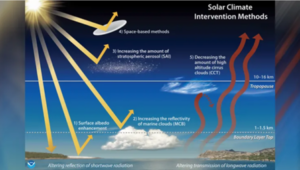Climate Engineering: Doubling Down on Bad Habits
by Gary Gardner

Let’s not mess with such perfection. (Wikimedia)
Social psychologists tell us it takes about 66 days to form a new habit. In my experience that’s only half true. Sixty-six days to form a good habit, yes, but about 66 hours to form a bad one. If I reach for a donut at breakfast, then do the same the next two days, I seal the deal and establish a habit of bad eating. And the dynamic has an insidious way of spreading. Soon I skip workouts, watch too much TV, and succumb to other indulgences. Poor choices beget poor choices, in a rapidly descending spiral.
We might frame climate engineering in the same way, as the latest in a downward spiral of bad economic choices. Our original sin was committing uncritically to growth. Then we doubled down using the power of fossil fuels. Now we flirt with climate engineering, a set of technologies that are expensive, risky, and often unproven, as an extension of our fossil energy addiction. Down the slippery slope we go.
Breaking our bad habit requires that we adopt a strict fossil-fuel-free diet. But we’ve reached a point where may also need some forms of climate engineering—limited and relatively benign—to restore stability to our climate and to reduce climate damage, especially in the most vulnerable regions. In our addiction to growth and fossil fuels we’ve wrought a vexing ethical tangle that will be difficult to sort through.
What is Climate Engineering?
Climate engineering, also known as geoengineering, is an umbrella term covering a broad set of technologies for avoiding dangerous levels of global heating. Analysts generally split the field into two families of technologies, each with a different approach to addressing warming.
Solar radiation modification (SRM) is a strategy for deflecting away the sun’s rays to reduce the heating of our planet. Scientists imagine increasing the albedo (reflectivity) of the earth, say by covering glaciers in Antarctica with artificial snow or planting high-albedo varieties of barley, corn, wheat, or other crops. More exotic options include spraying reflective sulphates into the stratosphere or placing orbiting mirrors in space. Proponents of SRM note that most of the options are relatively inexpensive, at tens of billions of dollars per year for each degree C of cooling in the sulphate-spraying option. And it would provide quick relief from rising temperatures. Other advocates may see SRM as an easy way to skirt emissions reductions and to maintain economies run by fossil fuels. And SRM has serious downsides, described below.

Forms of Solar Radiation Management. (Chelsea Thompson, NOAA/CIRES)
Carbon dioxide removal (CDR) approaches would pull carbon dioxide from the atmosphere, thinning the blanket of heat-trapping CO2 molecules. CDR is a testament to the human imagination, featuring more than a dozen methods of removing excess carbon. Some are nature-based, like planting trees over massive areas. Others are mechanical, like direct air capture (DAC), which uses giant fan-like devices to draw air through adsorbent filters that isolate the CO2, concentrating it for sequestration. Still others alter marine ecosystems by encouraging the growth of carbon-rich plankton (for example, by scattering iron filings through the ocean). The plankton then sink to the ocean floor for a natural burial. All these CDR methods have drawbacks, whether ecological, political, financial, or ethical.
Which approach is best, SRM or CDR? In truth, the question is premature. Before considering any merits of climate engineering, we must tackle the little matter of emissions reductions. This is the elephant in the room in many climate engineering discussions.
The multiple technologies proposed for tinkering with the climate can easily dazzle us. But gee-whiz excitement may blind us to an important fact. None of these solutions addresses the core driver of the climate crisis, the emission of greenhouse gases. None is a complete solution to our climate challenge.
All climate engineering approaches are workarounds that sidestep dealing with emissions. Every one is a temptation to avoid the painful task of building new, carbon-neutral economies. Each makes at best an incomplete contribution to solving the climate crisis.
An honest, fully formed approach to climate policy requires that emissions reductions be not only present, but at the forefront. Climate engineering should play only a distant, secondary role. Even then, only the most benign, ecologically friendly options should be considered.
Fundamental Failure
Remember that geoengineering strategies would not even figure in the climate conversation if humanity had met its responsibility for emissions reductions decades ago. But we didn’t. Between 2000 and 2022, the world’s economies emitted enormous quantities of carbon, equal to 41 percent of the carbon emitted back to 1750. This growth-driven surge boosted concentrations of atmospheric carbon from 370 to 418 parts per million).

Carbon sequestration as nature intended. (Niko photos, Unsplash)
The surge has also tied our hands: Atmospheric concentrations are now so great that emissions reductions alone cannot provide for the 1.5-degree (Celsius) limit on temperature rise set in the 2015 Paris Agreement. Nor are they likely to keep us below 2.0 degrees of temperature increase. In fact, most IPCC scenarios for meeting temperature goals assume some use of CDR technologies to sequester carbon. And the U.S. government seems intent on exploring climate engineering, having provided billions of dollars in subsidies to help boost direct air capture technologies.
In fact, the longer serious mitigation efforts are delayed, the more the mercury rises and the greater the pressure to use climate engineering. More carbon indulgence coaxes us toward more extreme tinkering with Earth systems. Bad habits breed bad habits.
In sum, we err in framing climate engineering as a set of wonder technologies arriving just in time to save us. Instead, they are like crutches, temporary assists that support the hard work of rehabilitation. Our hard work, our rehabilitation of the climate, is to reduce greenhouse gas emissions in a serious way.
What Could Possibly Go Wrong?
As helpful as some limited geoengineering practices may be, policymakers and the public must be clear-eyed about the risks involved. The list of risks is long. Here are just a few:
Rogue actors—What if a nation frustrated over feeble progress in cutting global emissions decided to take climate action into its own hands? It’s not as far-fetched as it may seem given the relative simplicity and affordability of sulphate spraying, at least for larger economies. Kim Stanley Robinson’s The Ministry for the Future imagined just such a scenario, with India suffering mass deaths due to heat and responding by essentially skywriting with cannisters of sulphate. The government, perhaps understandably, frames an exotic and risky venture as necessary to protect its suffering people.
Long-term commitment—SRM in particular could introduce a major new risk. If nations start to reflect away solar rays without serious emissions reductions, they essentially commit to SRM indefinitely. Stopping the practice after a buildup of carbon would produce a spike in global temperature that many species likely could not adapt to. Who has confidence that nations would fund SRM solutions indefinitely to avoid such an outcome?

Would climate engineering be in the interest of this young African? (Seth Doyle, Unsplash)
Unintended consequences—Some measures to restrain global temperature increases could have detrimental effects at the regional or local levels. For example, some forms of solar engineering could cause changes in rainfall in parts of Africa or to the monsoon in India. What safeguards can we put in place to protect vulnerable regions? Are people in those regions part of decision-making on climate engineering?
Resource intensive—For CDR technologies, global-level interventions will require tremendous resources, both financial and physical. Even tree planting is no panacea. Planting 900 million hectares in trees would require the area of 2.74 Indias, raising questions about whose land would be used. Even then, the trees would remove around 8 billion tons of CO2 equivalent. This is just a fraction of the 52 billion tons of CO2 equivalent emitted each year. And young trees absorb far less carbon than mature trees, so the bulk of these gains would not be realized until the second half of the century.
Unproven—In 2023, a panel in the U.N. climate bureaucracy shocked the emerging CDR community when it declared carbon removal technologies “technologically and economically unproven, especially at scale.” It also said that carbon removal poses “unknown environmental and social risks.” Even Ocean Visions, which is bullish on marine-based methods of CDR, acknowledges that many are untried and have unknown effects. This, even as the global community needs climate action urgently.
Finding the Moral Middle
If we were tasked in 1990 to lay out an ethics of climate action, a single sentence would have sufficed. Cut greenhouse gas emissions as broadly and quickly as possible, starting with the biggest emitters. But economic growth and technological developments since 2000 have complicated the picture considerably and put us in an ethical bind. Navigating our choices requires ramping up our commitment to emissions reductions while carefully considering other actions that would keep temperature increases under two degrees.
On curbing emissions, we’ll need to be much less permissive than we’ve been in the past two decades. Electric vehicles, solar panels, and other “clean” technologies are part of this effort, but they carry their own moral hazard. It’s tempting to believe that adopting technological fixes is the extent of our responsibility. But we know that technological solutions alone often backfire and can produce more of the very harms we are trying to reduce.

A good effort in itself, but even a trillion trees wouldn’t finish the emissions-mopping job. (Eyoel Kahssey, Unsplash)
The most direct, broad-based, and cheapest way to cut emissions is to stop the economic growth that fuels it. Policy efforts focused here could yield substantial returns. Some of the draft bills from CASSE’s Steady State Economy Act project (such as the Mileage Fee Act, to be introduced next week) would be helpful steps in this direction.
With a serious commitment to emissions reduction, we can turn to mopping up as much excess greenhouse gases from the atmosphere as is safely possible. Climate engineering solutions should be those that mesh with ecological restoration, like tree planting, restoring wetlands, and designating “blue carbon” areas. The simultaneous contribution to biodiversity conservation makes such efforts a systems solution to the climate crisis. This stands in contrast to the single-issue, reductionist focus that characterizes many climate engineering approaches.
We got into the climate crisis by relying on tunnel-visioned engineering solutions. Let’s not double down on that mistake by tinkering with the climate. Greta Thunberg captures the idea: “A crisis created by lack of respect for nature will … not be solved by taking that lack of respect to the next level.”
Instead, let’s respect nature—and ourselves—and abandon the naïve notions of perpetual growth. We have the option of the steady state economy to fall back upon. It’s the adult thing to do.
Gary Gardner is Managing Editor at CASSE.

The post Climate Engineering: Doubling Down on Bad Habits appeared first on Center for the Advancement of the Steady State Economy.